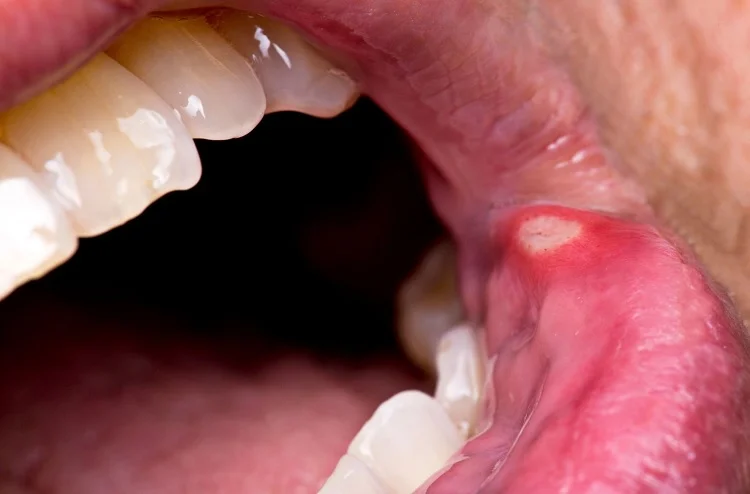Last Updated on: 28th June 2024, 02:09 pm
✓ Fact Checked 🕓
❙ Our team of writers, editors, and medical experts rigorously evaluates each article to ensure the information is accurate and exclusively cites reputable sources.
❙ We regularly assess how the content in this article aligns with current scientific literature and expert recommendations in order to provide the most up-to-date research.
Here we share information about the proper treatment for canker sores and the management of the discomfort during those initial days. You can find information on canker sores and their causes and symptoms on our website.
Canker sores are those small lesions that appear in the mouth and produce a painful sensation They can cause discomfort when eating or brushing the teeth, and heal on their own in an average of seven days.
It is estimated that more than half of the world’s population has had a canker sore at some point. 80% of 30 years of age have been affected, although this oral health condition is more frequent in women due to their hormonal differences.
Canker sores are classified into three variants according to their characteristics:
• Minor: They are small in size and occur in people between the ages of 10 and 20. They heal in an average time of a week, without leaving a trace.
• Greater: They are larger and deeper. They can be extremely painful and can take more than two weeks to heal, leaving a scar.
• Herpetiformis: They appear in the elderly but are rare. They are small in size and heal in one or two weeks, leaving no scar.

The diagnosis
Canker sores are generally benign, although on some occasions they can be an indicator of other health conditions that require further attention.
In most cases, adolescent women often present canker sores, as it is related to the menstrual cycle. During this period there is an alteration in the acidity (PH) of saliva, making the oral environment conducive to infections.
If there is a fever, difficulty eating, or spots on the hands and/or feet, it may be another type of virus or bacteria.
A health professional should be consulted in the following cases:
• Tiredness, without apparent cause, for several days.
• Stomach ache.
• High fever, diarrhea, headache, or skin rash.
• Very large wounds that spread through the mouth.
• Mouth sores that last more than three weeks. If you want to learn about blood blisters in the mouth, you can check the article here.
• Difficulty in drinking liquids.
• Frequent oral lesions (ulcers).
• Sores on other parts of the body.
• Irritated eyes.
If the wounds are intermittent – they appear and disappear – and are deep and large, a doctor should be consulted to identify if this indicates another type of disease.
In some cases, canker sores are symptoms of systemic diseases, such as:
• Ulcerative colitis and inflammation of the colon and rectum that causes diarrhea and abdominal pain.
• Behçet’s disease and inflammation of the blood vessels produce thrush in 90% of cases.
• Celiac disease, a condition of the immune system that prevents the proper consumption of gluten.
• Crohn’s disease, a chronic inflammation that affects the digestive tract.
• Cyclic neutropenia affects the levels of production in bone marrow stem cells, a condition that increases the possibility of infections.

Treatment for canker sores
The discomfort caused by thrush disappears with the passage of time.
To manage pain and discomfort, it is recommended to control the predisposing factors, such as foods or substances that irritate the mouth. It is important not to scrape on the lesion in an attempt to remove the white spot.
Home treatment for canker sores is an alternative that facilitates the management of the discomfort. It is suggested to:
Apply:
• Compress of milk of magnesia on the canker sore.
• Clove oil compresses. First, the mouth is washed with mouthwash and with cotton or gauze, and the oil is applied directly to the sore.
• Compresses of hydrogen peroxide (hydrogen peroxide) on canker sores. Dilute one part peroxide to two parts water.
• Chamomile compresses.
• Coconut oil on the lesion several times a day.
• Aloe vera gel (the aloe crystals) swabbed on the lesion.
• Ice on the canker sore to relieve pain.
• Alum paste. A few drops of water mixed with a small amount of powdered alum form a paste that can be applied daily to the lesion for a minute and then rinsed off.
Rinse with:
• Warm salt water or baking soda.
• Echinacea infusion three times a day. Mix one part of liquid echinacea and dissolve it in two parts of water.
• Sage infusion. In a cup of boiling water, put two teaspoons of fresh sage leaves. Allow the mixture to stand for 5 minutes, filter the liquid, and then rinse the mouth for a few minutes.
• Apple vinegar. Mix a teaspoon of vinegar in a cup of water. Rinse for 30 seconds. Rinse the mouth water to avoid irritation.
Take or imbibe:
• Carrot, celery, or melon juice.
• Chamomile tea with honey at a lukewarm temperature. Honey has antiseptic properties while chamomile reduces inflammation.
Another therapeutic option is the use of medications, such as:
• Local over-the-counter topical anesthetics and/or disinfectants.
• Antibiotics or corticosteroids, according to the diagnosis and medical prescription.
• Consume zinc and vitamin C pills.
In general, treatment for canker sores seeks to reduce pain, discomfort, and inflammation. Canker sores evolve and heal without major complications, although it is advisable to opt for some basic care that does not irritate the mouth or canker sores.
If the canker sore causes fever, headache, or a skin rash, it takes more than two weeks to evolve. If it is very large, you are advised to consult your doctor to find out the diagnosis and suitable treatment.
Frequently Asked Questions
How do you quickly heal a canker sore?
To alleviate pain and speed up healing, try these tips: Rinse your mouth with salt water or a baking soda solution (dissolve 1 teaspoon of baking soda in 1/2 cup of warm water). Apply a small amount of milk of magnesia to the canker sore a few times a day.
What is the most effective medication for canker sores?
Common medications for canker sores include carbamide peroxide (Gly-Oxide), chlorhexidine gluconate, and silver nitrate. Research indicates that these treatments can alleviate pain and promote faster healing. For more severe canker sores, steroids are another effective option.
What is the quickest way to cure a mouth ulcer?
Apply an antiseptic gel to the ulcers. Rinse your mouth with warm, lightly salted water, holding the rinse in your mouth for up to 4 minutes each time. Repeat this process four times a day. Additionally, use an alcohol-free medicated mouthwash, preferably containing chlorhexidine gluconate, twice daily.
Does honey help with canker sores?
Honey is renowned for its antibacterial and anti-inflammatory properties. Research indicates that honey can aid in wound healing, potentially reducing the pain, size, and redness of canker sores. It may also help prevent secondary infections. To use, apply honey to the sore four times a day.
What aggravates canker sores?
Spicy and acidic foods, like lemons or tomatoes, can be very painful on open sores. Avoid hard, scratchy, or crunchy foods such as nuts, toast, pretzels, or potato chips, as they can irritate or rub against the sore. Additionally, be gentle when brushing your teeth.
Share:
References
1. Cleveland Clinic (September 6, 2019)Cake Sores / https://my.clevelandclinic.org/health/diseases/10945-canker-sores
2. Hennessy, Bernard (February 2022)Recurrent aphthous stomatitis / https://www.msdmanuals.com/es/professional/trastornos-odontol%C3%B3gicos/s%C3%ADntomas-de-los-trastornos-bucales-y-dentales/estomatitis-aftosa-recurrente?query=Estomatitis%20aftosa%20recidivante
3. Kids Health (September 2021)Canker Sores / https://kidshealth.org/en/kids/canker.html
4. Left, Regina (March 18, 2019)Cold sores / https://cinfasalud.cinfa.com/p/aftas-bucales/
5. MacGill, Markus (June 9, 2017)Everything you need to know about canker sores / https://www.medicalnewstoday.com/articles/303311
6. McDermontt Annette (May 12, 2022)Ways to Get Rid of Canker Sores / https://www.healthline.com/health/dental-and-oral-health/how-to-get-rid-of-canker-sores
7. NIH, (September 2021)Fever Blisters & Canker Sores / https://www.nidcr.nih.gov/health-info/fever-blisters-canker-sores
8. Rioboo Crespo M, Bascones M. A (April 2011)Thrush of the oral mucosa. Advances in Odontostomatology Magazine, Volume 27 / https://scielo.isciii.es/scielo.php?script=sci_arttext&pid=S0213-12852011000200002
9. Robertson, Jennifer (May 18, 2022)A Guide to Prescription and OTC Canker Sore Medications / https://www.goodrx.com/conditions/canker-sores/how-do-you-treat-a-canker-sore
10. Sissons, Claire (December 10 of 209) Nine ways to treat canker sores / https://www.medicalnewstoday.com/articles/320015
11. TeensHealth (September 2021)Canker sores /https://kidshealth.org/es/teens/canker.html
12. WebMed (May 12, 2021)Canker Sore (Apthous Ulcer) / https://www.webmd.com/oral-health/guide/canker-sores














